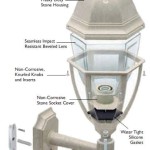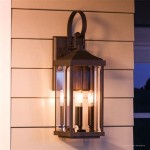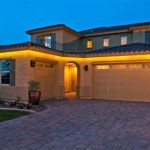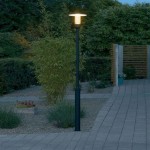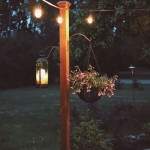```html
Stainless Steel Outdoor Lights: Durability and Design for Exterior Illumination
Stainless steel outdoor lights represent a popular choice for enhancing the aesthetic appeal and functionality of exterior spaces. Their robust construction and resistance to corrosion make them a durable option for various weather conditions. This article will explore the benefits, types, installation considerations, and maintenance practices associated with stainless steel outdoor lighting fixtures.
Aesthetic Versatility and Modern Appeal
Stainless steel provides a clean and contemporary aesthetic that complements a wide range of architectural styles. The neutral, metallic finish blends seamlessly with various exterior materials, including brick, wood, stone, and stucco. This versatility allows homeowners and landscape designers to integrate stainless steel lights into diverse settings, from modern minimalist designs to more traditional landscapes. The reflective properties of stainless steel also contribute to brighter illumination, distributing light more effectively across surfaces.
Furthermore, stainless steel is available in different finishes, such as brushed, polished, and powder-coated, offering further customization options. Brushed stainless steel provides a subtle, matte appearance that minimizes glare, while polished stainless steel offers a more reflective and striking visual effect. Powder-coating allows for the application of various colors, enabling designers to introduce specific color tones to the lighting scheme. The inherent adaptability of stainless steel enables the creation of customized outdoor lighting designs that align with specific aesthetic preferences and architectural requirements.
The sleek appearance of stainless steel lighting fixtures also lends itself well to highlighting specific architectural features or landscaping elements. Spotlights can be strategically placed to accentuate unique building details, sculptures, or water features. Path lights guide visitors along walkways, providing both safety and visual interest. The understated elegance of stainless steel ensures that the lighting fixtures enhance the surrounding environment without overwhelming it.
Durability and Corrosion Resistance
Stainless steel is renowned for its exceptional durability and resistance to corrosion, making it an ideal material for outdoor lighting applications. The alloy's composition, which includes chromium, forms a passive layer on the surface that protects the underlying metal from oxidation and rust. This inherent corrosion resistance ensures that stainless steel lighting fixtures can withstand exposure to various environmental factors, including rain, snow, salt spray, and UV radiation.
The grade of stainless steel used in the manufacture of outdoor lights plays a crucial role in determining its long-term performance. 304 stainless steel is a common grade known for its good corrosion resistance and versatility. It is suitable for most residential applications where exposure to harsh chemicals or extreme salt spray is minimal. However, for coastal environments or areas with high levels of pollution, 316 stainless steel is often preferred. This grade contains molybdenum, which enhances its resistance to chloride corrosion, making it more suitable for marine and industrial environments.
The robust construction of stainless steel lighting fixtures also contributes to their longevity. These fixtures are typically designed to withstand physical impacts and vibrations, ensuring that they can withstand the rigors of outdoor use. Sealed components protect the internal wiring and electrical connections from moisture and debris, further extending the lifespan of the lighting system. The combination of corrosion resistance and structural integrity makes stainless steel outdoor lights a cost-effective investment in the long run.
Proper maintenance, while minimal, is still important to maximize the lifespan of stainless steel outdoor lights. Regular cleaning with a mild soap and water solution can remove dirt, grime, and other contaminants that can accumulate on the surface. Avoiding harsh chemicals or abrasive cleaners is essential to prevent damage to the protective layer of the stainless steel. Periodic inspection of the fixtures for any signs of damage or corrosion can allow for early intervention and prevent more serious problems from developing.
Types of Stainless Steel Outdoor Lights and Their Applications
Stainless steel outdoor lights are available in a wide variety of styles and configurations to suit diverse lighting needs and aesthetic preferences. Understanding the different types of fixtures and their specific applications is essential for creating a well-designed and functional outdoor lighting scheme.
Path Lights: These low-level lights are designed to illuminate walkways, driveways, and garden paths. They provide safety and guidance while also adding a decorative element to the landscape. Stainless steel path lights are available in various heights and designs, from traditional lantern styles to more contemporary minimalist forms. They typically use low-wattage LED bulbs to provide energy-efficient illumination.
Spotlights: Spotlights are used to highlight specific architectural features, landscaping elements, or focal points in the garden. They can be adjusted to direct light onto trees, shrubs, sculptures, or building facades. Stainless steel spotlights are often equipped with adjustable heads and mounting brackets, allowing for precise aiming of the light beam. They are available in various sizes and wattages to suit different lighting requirements.
Wall Lights: Wall-mounted lights are used to illuminate doorways, porches, and patios. They provide ambient lighting for outdoor living spaces and enhance security around the home. Stainless steel wall lights are available in various styles, from traditional lanterns to modern sconces. They can be wired directly into the electrical system or powered by solar energy.
Flood Lights: Flood lights provide broad illumination for large areas, such as driveways, parking lots, and backyards. They are often used for security purposes to deter intruders. Stainless steel flood lights are typically equipped with high-intensity LED bulbs or halogen lamps to provide bright and uniform lighting. They are often mounted on poles or walls to maximize their coverage area.
Deck Lights: Deck lights are specifically designed for installation on decks and patios. They provide ambient lighting for outdoor entertaining and create a warm and inviting atmosphere. Stainless steel deck lights are typically flush-mounted or surface-mounted and are available in various sizes and shapes. They are often equipped with low-voltage LED bulbs to provide energy-efficient illumination.
In addition to these common types, stainless steel is also used in the construction of bollard lights, underwater lights for ponds and fountains, and even string lights. The versatility of the material allows for creative and innovative lighting solutions for virtually any outdoor application.
Installation and Wiring Considerations
Proper installation and wiring are crucial for ensuring the safe and reliable operation of stainless steel outdoor lights. It is essential to follow all local electrical codes and safety regulations when installing outdoor lighting fixtures. If you are not comfortable working with electrical wiring, it is recommended to hire a qualified electrician to perform the installation.
Before beginning the installation process, it is important to plan the layout of the lighting system and determine the placement of each fixture. Consider the location of existing electrical outlets and wiring, as well as any underground utilities. It is also important to ensure that the selected fixtures are suitable for the intended location and application. For example, fixtures installed near swimming pools or other bodies of water must be specifically rated for wet locations.
When wiring stainless steel outdoor lights, it is essential to use weatherproof connectors and junction boxes to protect the electrical connections from moisture and corrosion. Bury underground wiring in conduit to prevent damage from digging or other activities. Always disconnect the power supply before working on any electrical wiring. Follow the manufacturer's instructions for wiring each fixture, paying close attention to the polarity of the wires.
Some stainless steel outdoor lights are powered by low-voltage transformers, which convert standard household voltage (typically 120 volts) to a lower voltage (typically 12 volts). Low-voltage systems are safer to work with and can be easier to install, as they require less stringent wiring requirements. However, low-voltage systems may require a larger transformer and may be less suitable for long runs of wiring.
Solar-powered stainless steel outdoor lights offer an alternative to traditional wired systems. These fixtures are equipped with solar panels that collect energy from the sun and store it in batteries. They are easy to install and require no wiring, making them a convenient option for remote locations or areas where running electrical wiring is not feasible. However, solar-powered lights may not provide as much light as wired fixtures, and their performance can be affected by weather conditions.
Regardless of the type of lighting system used, it is important to test the system after installation to ensure that all fixtures are working properly. Check for any loose connections or wiring problems. Regularly inspect the system for any signs of damage or wear and tear, and make any necessary repairs promptly.
Maintenance and Longevity
While stainless steel is a durable material, regular maintenance is necessary to ensure the longevity and optimal performance of outdoor lighting fixtures. Proper maintenance practices can help prevent corrosion, maintain the aesthetic appearance of the fixtures, and extend their lifespan.
One of the most important maintenance tasks is regular cleaning. Use a mild soap and water solution to remove dirt, grime, and other contaminants from the surface of the stainless steel. Rinse thoroughly with clean water and dry with a soft cloth. Avoid using harsh chemicals or abrasive cleaners, as these can damage the protective layer of the stainless steel and cause discoloration or corrosion.
For areas with high levels of salt spray or pollution, it may be necessary to clean the fixtures more frequently. Consider applying a stainless steel cleaner or polish to help protect the surface from corrosion and maintain its shine. Follow the manufacturer's instructions for using these products.
Inspect the fixtures regularly for any signs of damage or corrosion. Check for loose screws, cracked lenses, or damaged wiring. Repair any damage promptly to prevent further deterioration. Replace any bulbs that have burned out. If you notice any signs of corrosion, clean the affected area thoroughly and apply a rust inhibitor.
Protect the fixtures from physical damage by trimming back any overgrown vegetation that may rub against them. Avoid using the fixtures as supports for climbing plants or other objects. If you live in an area with severe weather conditions, consider removing the fixtures during the off-season and storing them in a safe place.
By following these maintenance practices, you can help ensure that your stainless steel outdoor lights provide years of reliable and beautiful illumination.
```
Modern Stainless Steel Outdoor Light With Pir Sensor 6211

Contemporary Stainless Steel Led Garden Wall Light Ip44 Rated

Stellus Classica 320 Wl Stainless Steel Outdoor Wall Lantern

Motion Sensor Wall Lights Classica S Steel Outdoor Pir Lantern

Vailridge 20 High Stainless Steel Led Outdoor Wall Light 59j57 Lamps Plus

Alpha Stainless Steel Outdoor Wall Light 4908st The Lighting Super

Treviso Brushed Stainless Steel Outdoor Wall Light

Grant Outdoor Up Down Led Wall Light Stainless Steel Bhs

Stainless Steel Exterior Lights Lamps Buy Light11 Eu

Firstlight 8352st Modern Stainless Steel Outdoor Garden Wall Light Lighting
